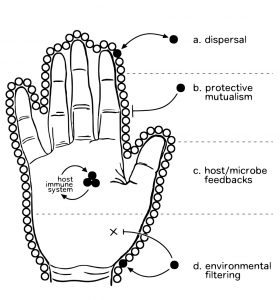Three postdoctoral positions in microbial ecology and plant-microbe interactions Position descriptions available below and on the UW job site (positions 9465, 9480, 9466) at https://tinyurl.com/yd3qoag3 Post Doctoral Research Associate in Microbiology and Microbial Ecology (position 9465): The Ward research group at the University of Wyoming is seeking a postdoctoral researcher in microbiology and microbial ecology. Minimum requirements include a Ph.D. in a relevant discipline, and experience in …
(This post was written by Roo Vandegrift at the University of Oregon) I was recently asked to spearhead the writing of a review centered around the interaction between the concept of hygiene and our increasingly nuanced understanding of the human skin microbiome for the Biology and the Built Environment (BioBE) Center at the University of …
Sadly I am not able to go to this this year but it looks really good. 21-26 August 2016 | ISME-International Society for Microbial Ecology. Lots of great sessions and speakers. Follow along via Twitter hashtag #ISME16. #ISME16 Tweets !function(d,s,id){var js,fjs=d.getElementsByTagName(s)[0],p=/^http:/.test(d.location)?’http’:’https’;if(!d.getElementById(id)){js=d.createElement(s);js.id=id;js.src=p+”://platform.twitter.com/widgets.js”;fjs.parentNode.insertBefore(js,fjs);}}(document,”script”,”twitter-wjs”);
From May 13-14 2015 we hosted a “Live/Dead Workshop” here at UC Davis where we basically discussed a number of issues related to the topic of figuring out which bacteria are alive/viable in a given microbial community. This is particularly important in the built environment where we suspect that many (most?) microbes are dead and …
Many of us are familiar with the story of the wolves in Yellowstone that scare away hungry elk herds from tasty young willows (although the ecology of Yellowstone is probably more complicated than that). Nonetheless many ecologists are keenly interested in what has been termed the ecology of fear in communities of plants, birds and mammals. The ecology of fear describes the role of …
Every day, diverse microbial communities with cell levels of 106-108 cells/liter migrate from drinking water treatment plants through a complex network of pipes in drinking water distribution systems and into our built environment. Managing this mass migration is critical from multiple perspectives. Some of these microorganisms can make consumers ill, some can contribute to pipe …
Last week, Holly Ganz from microBEnet organized a workshop on “Animals in the Built Environment”, focusing on the intersections between animal care, building design, and microbial ecology. Participants included zoo staff, shelter architects, engineers, microbial ecologists, etc. More detailed meeting reports will follow, but as a teaser here is the Storify from the meeting:
There is a paper that just was published that possibly will be of interest to those interested in studying microbial ecology of drinking water (or other water systems for that matter): Methodological approaches for studying the microbial ecology of drinking water distribution systems. Unfortunately the paper is not freely or openly available. The paper covers many topics …
In response to Hal Levin’s comment on my previous post: Thank you ISIAQ for the “Vocabulary of the Indoor Air Sciences” I am starting to put together some definitions and background information on the terminology of microbial ecology studies. Please suggest any / all terms that you think would be useful to define and I will …
I’ve been remotely following the Sloan MBE meeting discussions (happening in Boulder, CO this week), and yesterday there was a lot of Twitter discussion focused on data visualization tools. How do we make sense of the millions of DNA sequences we generate from microbial ecology projects in the Built Environment? I thought I’d use this opportunity to highlight …

